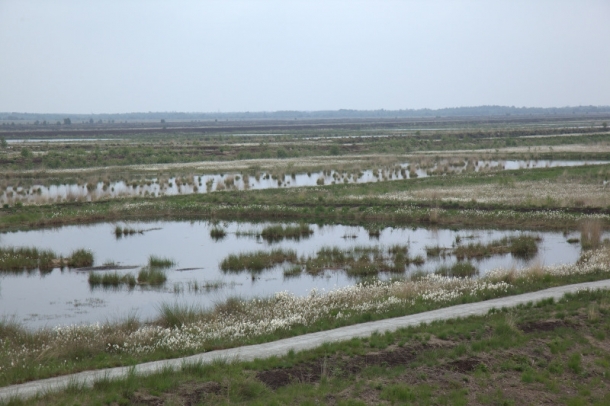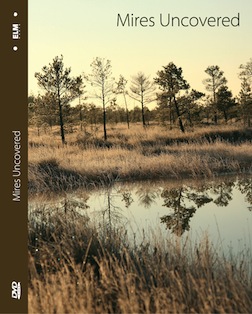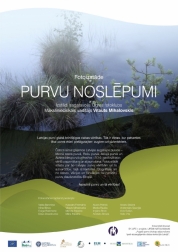Wetland Management in Germany 20/07/2010 00:00
In June 2010 the team of the EC LIFE project "Restoration of Raised Bog Habitats in the Especially Protected Nature Areas of Latvia" visited the peatlands in Germany (Lower Saxony and Bavaria) where the restoration of raised bogs was carried out in the frame of the EC financed LIFE projects. Several decades ago raised bogs were more widespread in Germany. Due to the increase of industrial peat extraction, most of the bogs were damaged or destroyed.
In the Institute Botany and Landscape Ecology Institute (Institut für Botanik und Landschaftsökologie) Greifswald University (Ernst-Moritz-Arndt-Universität Greifswald), in the laboratory of Botanical Garden different Sphagnum species and several other mire plants, like Drosera rotundifolia are grown to observe the possible cultivation in the field. Small pieces of Sphagnum are planted on the floating mattresses. Specific conditions are maintained in the laboratory: artificial lighting is activated when necessary, species are moistened by rain water, and suitable temperature is maintained. Sphagnum species are grown also outside the laboratory - in the pilot areas that were previously cut for peat but presently are flooded peat fields. Growth conditions in the field there are very different – Sphagnum species are affected by nitrate pollution, environmental conditions are not as constant as in the laboratory. The studies in the laboratory and in the field are carried out by Anja Prager and Franziska Gahlert supervised by Prof. Hans Joosten from the Greifswald University. The researchers have found out that the Sphagnum green mass can be used in gardening as effectively as peat and think that in the future it will be possible to grow Sphagnum moss on floating mattresses in the harvested peatlands. These studies are financed by peat cutting industry.
In Lower Saxony, in Wiefelstede, Stapeler Moor the project team under the guidance of Heinrich Belting and local experts were taken to the peat fields where the bog restoration was started nearly a decade ago. The German colleagues have raised water level in milled fields by flooding one part after another. To see the how the bog restoration is going on, a nature trail and bird watching tower was built. This milled area is surrounded by natural raised bog vegetation which is included in a protected nature area. This territory can serve as seed "bank" from which the plants can occupy the harvested bogs. The project team also visited Leegmoor in Aurich and Moorerlebnispfad Esterwegen near Osterbrook.
The next day Friedhelm Niemeyer guided the project team through Diepholzer Moorschnucke bog near Rehden. In order to maintain an open peatland area and to prevent from Molinia grass, grazing by sheep was introduced.
Suzanne Belting in Großen Torfmoores near Lübbecke has leaded the bog restoration during LIFE project "Regeneration des Großen Torfmoores". She guided to the restored areas of the raised bog along the boardwalk to tell about the bog restoration carried out in the LIFE project.
To get to know the Bavarian peatlands the project team went along with the LIFE project "Rosenheimer Stammbeckenmoore" leaded by Ralf Strohwasser and tractor operator who have built the dams in the project site to restore the bog hydrology and habitats. To show the bog values near the Bad Feilnbach in Sterntaler Filze a board walk was built there. With the help of young volunteers from all over Europe, a footbridge, entertainment area for children was built, as well as the trail and the bird watching site was adapted for people with special needs. Together with Ralf Strohwasser the project team visited also Kollerfilze near to Nicklheim.
Daniel Kufner works on the project "Biotopverbund" aimed at reconciling the two sanctuaries near Eggstätt with "eco-tunel" so plants and animals from one site to other can move. One of the sites was visited by the project team. Burghamer Filz Nature Reserve is a glacial lake system with various mire habitats near the lakes and the lower areas. Peat extraction has never been carried out there. Although it is a nature reserve, there is a dense road network that is used for recreation. The glacial lakes are used for swimming.
In the study tour the whole LIFE project team participated: the project manager Māra Pakalne, field manager Gunārs Balodis, project assistant Aivars Slišāns and public awareness coordinator Daiga Brakmane.












